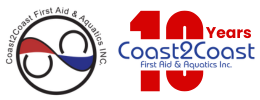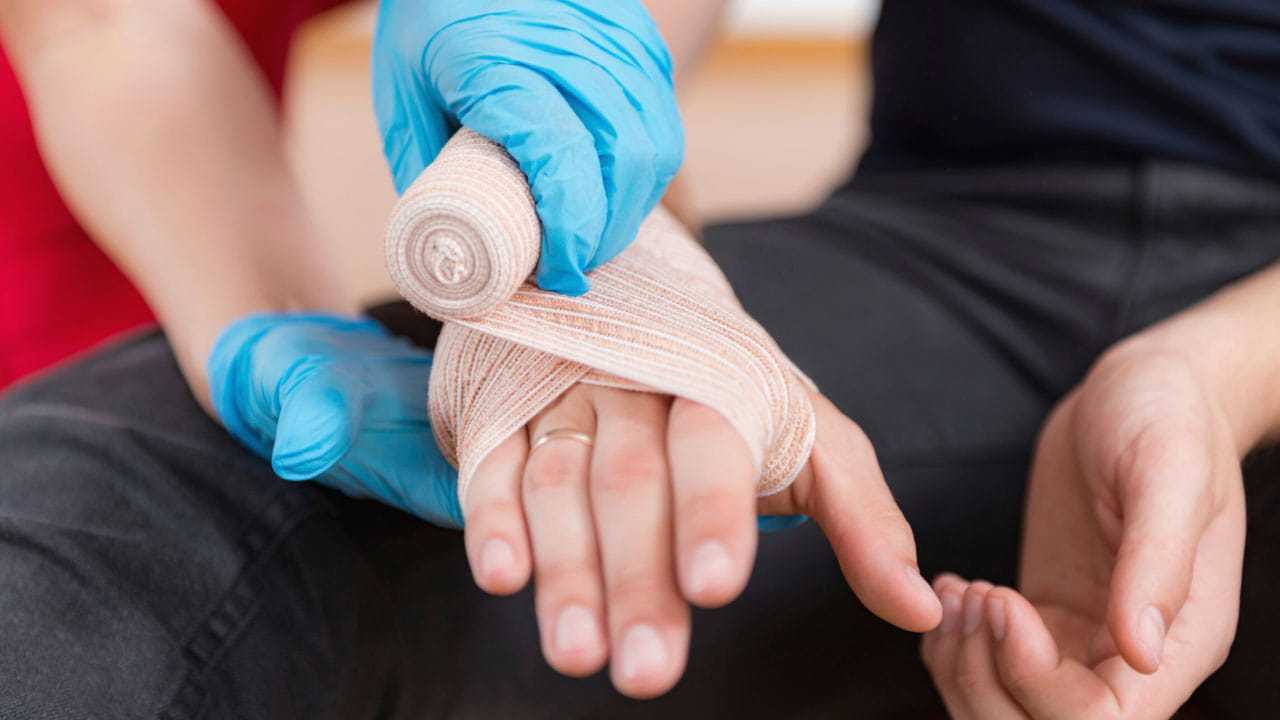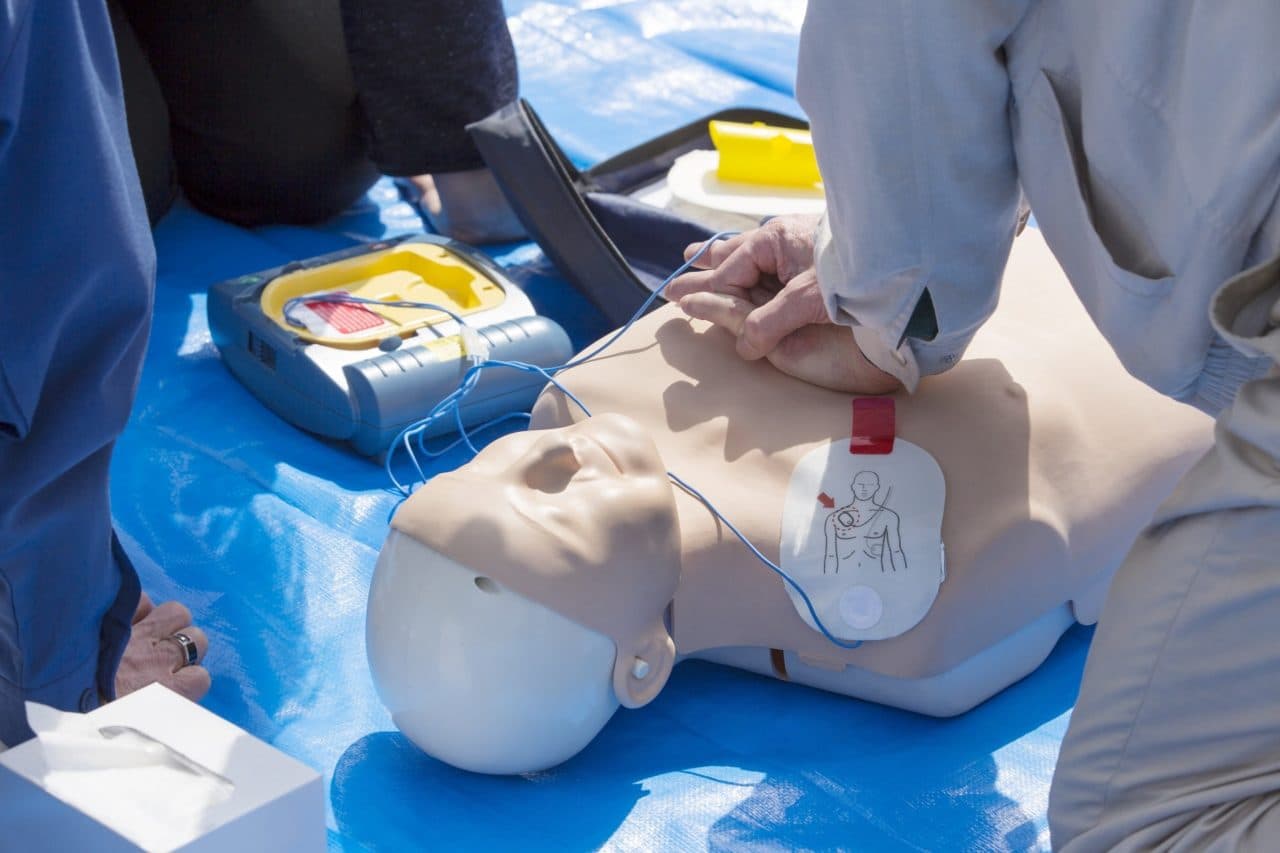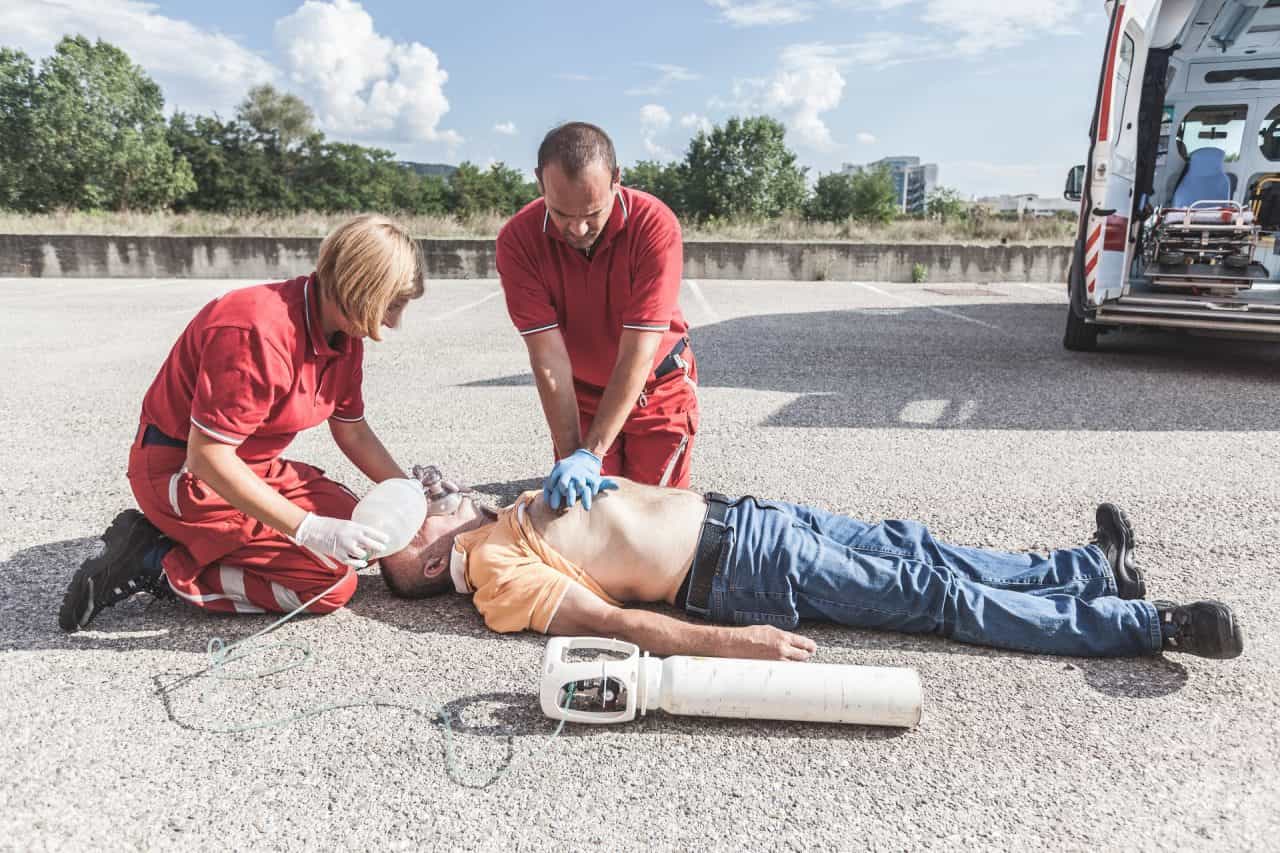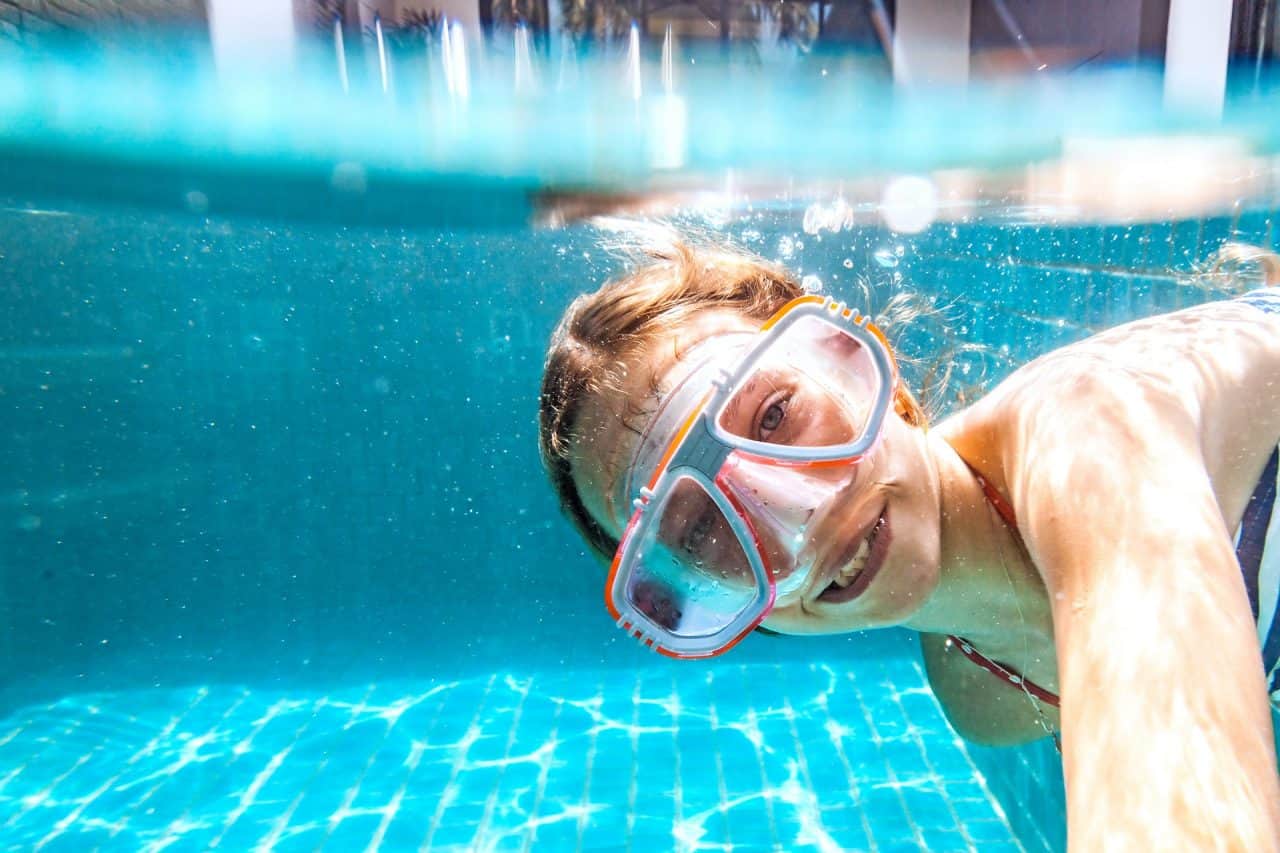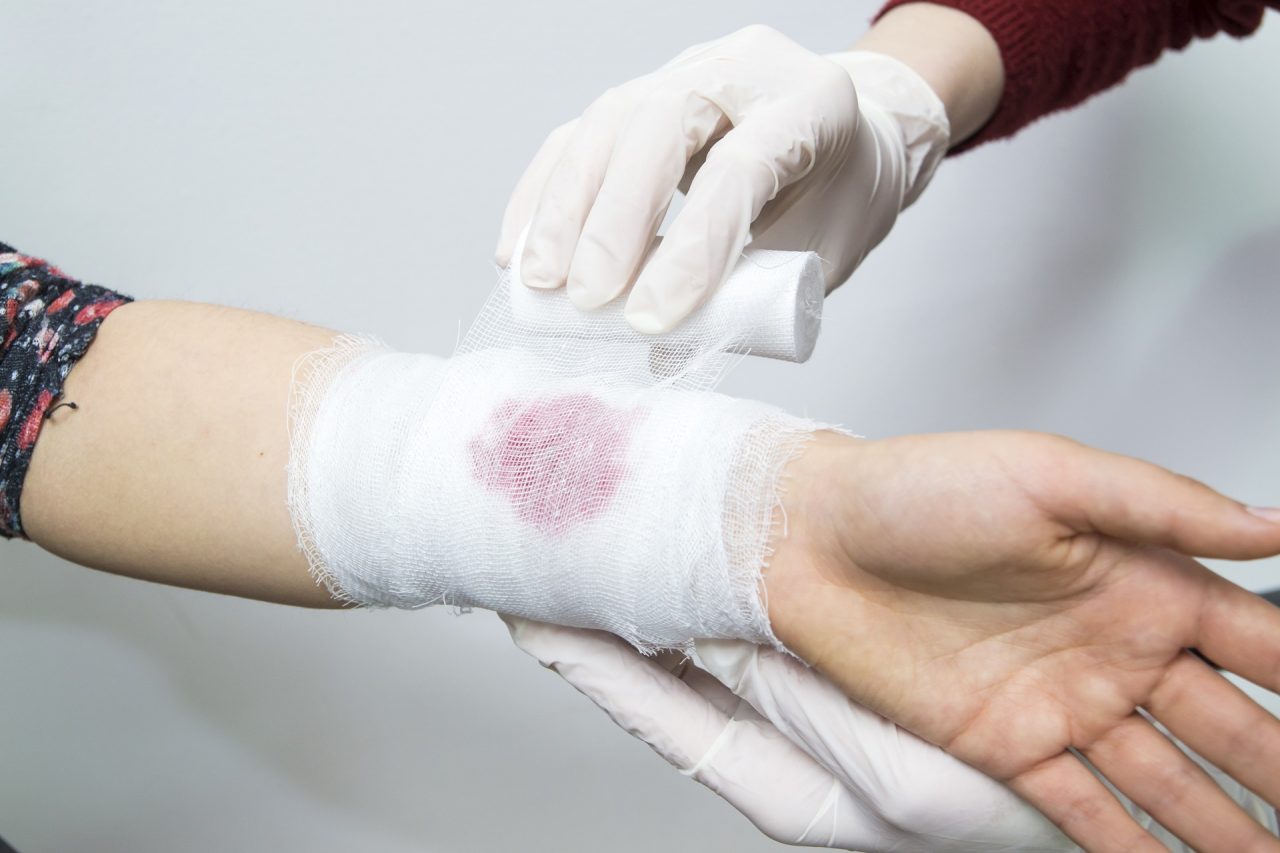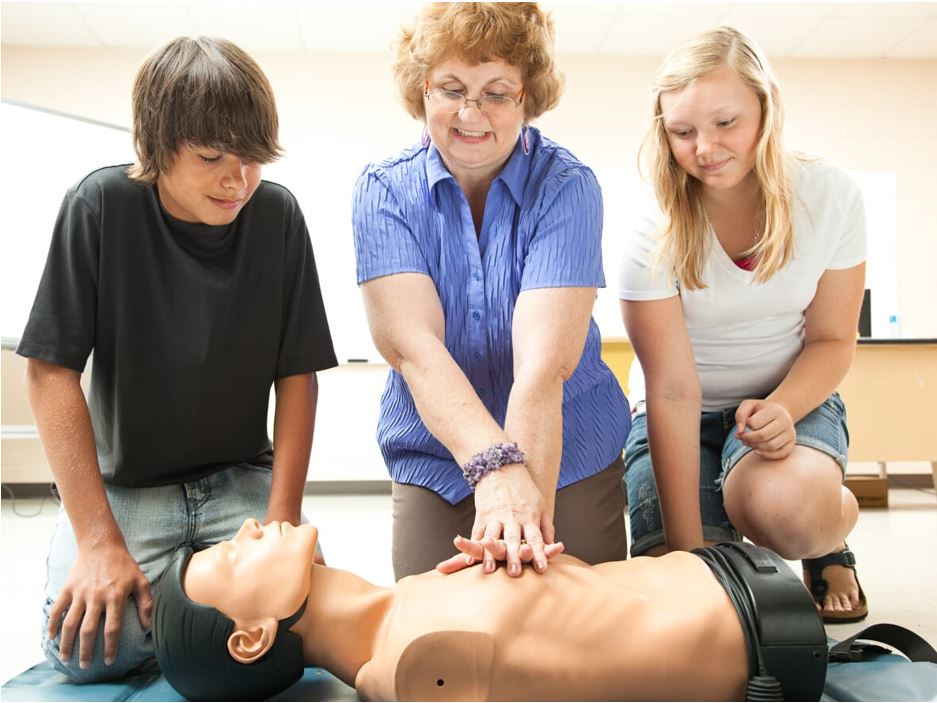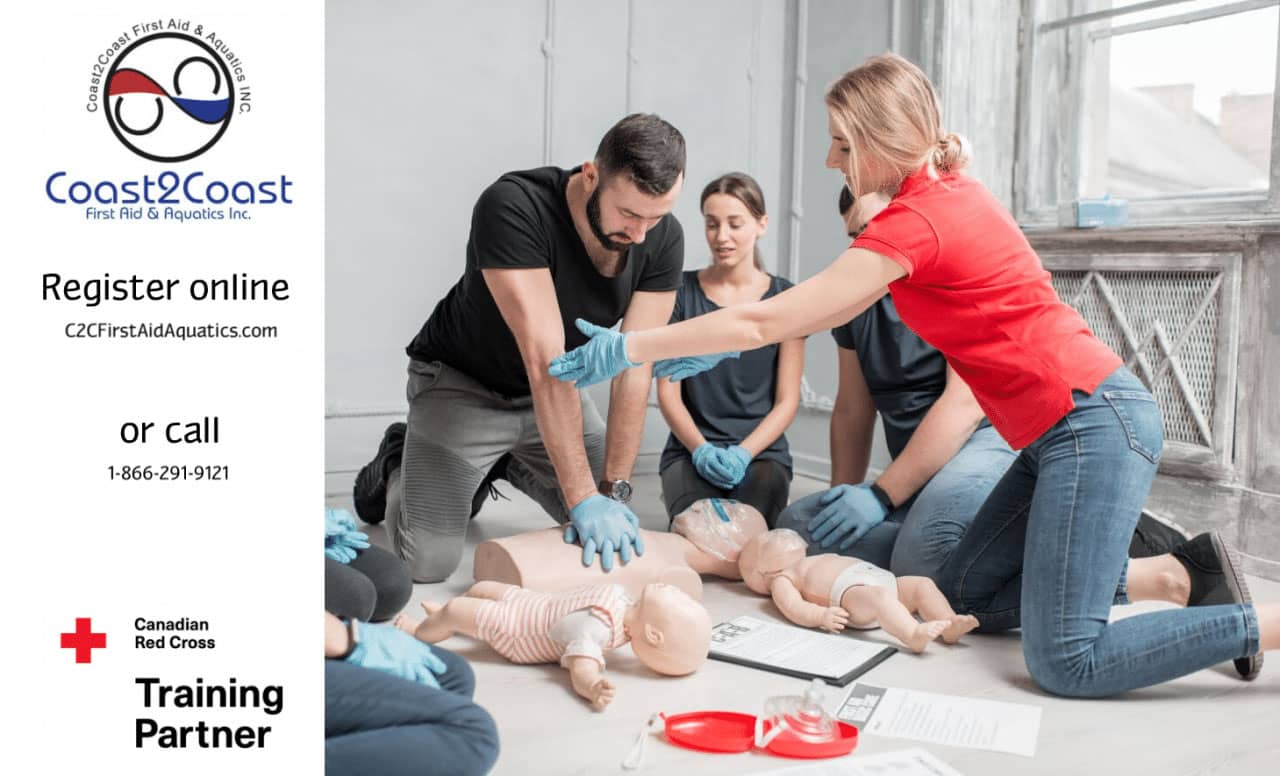The holidays are fast approaching and we are celebrating it with amazing prizes you can win just in time for Christmas! Join in on our Holiday Giveaways from now until December 22, 2019.
Continue readingThe Importance of Owning a First Aid Kit
Injuries: they happen daily whether we are prepared for them or not which is why it is important to have a first aid kit handy at all times. There are many incidents that occur to those who do not have easy access to a fully stocked first aid kit, making them susceptible to further injuries. Understand the importance of owning a First Aid Kit, where you should store one and what it should be stocked with.
Continue readingA Guide to Knocked Out Tooth Emergencies
As children, we all patiently (or impatiently) waited for our baby teeth to fall out. As adults, when we see a tooth or a segment of a tooth fall out, we become scared and frightened. We have been taught since an early age that your adult teeth are your only teeth, so it is in your best interest to keep them clean and safe of harm’s way.
Continue readingKnowing CPR Can Save Lives
More than 300 thousand people die because of cardiac arrest every year. The risk of heart disease is higher in senior citizens. 70% of adults above the age of 60 have some kind of cardiac problem in their lifetimes. There are many different types of health issues that can be the cause of cardiac arrest as well as other social factors that can lead to this situation of life or death. Knowing CPR can save lives.
Continue readingWhy Don’t you Offer the CPR HCP Course?
Recently, we have received many questions asking us if we provide CPR-HCP courses. Many professions require employees to be CPR and First Aid certified. Each job title requires you to attain a specific certificate, so it is important you sign up for the correct course(s). We recommend that you speak to your employer about which course you are required to take.
Why don’t we offer CPR-HCP?
As of April, the Canadian Red Cross has replaced CPR-HCP with Basic Life Support (BLS) courses. BLS is still the necessary course designed for healthcare providers, but now covers more information and goes into further detail about each topic that is covered. What was once a one hour course is now a four hour course with the option to include additional topics such as Airway Management and Oxygen Therapy.
Is BLS the same as CRP-HCP? In short, no, but it is the newly required course for healthcare providers now.
Why has HCP been replaced by BLS?
There are a couple reasons why HCP has been replaced by BLS. One reason is to create a clear distinction from all public CPR courses. Heathcare providers require specific training due to the professional environment they work in. The BLS course focuses on high-performance resuscitation in a team environment which is much different from normal CPR courses.
Another reason HCP has been replaced by BLS is because of the course content. Originally, HCP covered limited topics over a short duration. There was not enough time or information for students to learn important, life-saving skills for their jobs. BLS takes place over four hours and covers more detail about the topics learned in HCP while also teaching additional skills.
Who needs a BLS certificate?
Those who need a BLS certificate are typically those who work in a hospital setting such as nurses and medical doctors. Other professions, such as dentists, may require the BLS certificate as well, but you would need to check with your employer to confirm.
Master the Essentials of Basic Life Support!
Join our BLS course at Coast2Coast and learn critical skills that can save lives. Our experienced instructors will guide you through hands-on training, ensuring you’re prepared to respond in emergencies.
Is the BLS certificate valid nationally?
Yes. BLS certificates issued by the Canadian Red Cross are valid throughout Canada.
How do I renew my BLS certificate?
BLS is a certificate that must be renewed every year. Course materials are always changing, so it is important to keep your knowledge up to date. Healthcare providers must be able to fulfill their duties in the workplace, so keeping your certificate up-to-date is crucial.
Coast2Coast BLS Course
Coast2Coast offers many morning and evening BLS courses guaranteed to fit your schedule. Each course is taught by a highly trained Canadian Red Cross instructor. Once you complete the course and pass the multiple choice exam with a 75% score or higher, you will receive your certificate from the Canadian Red Cross. All certificates will be processed within 5-10 business days online.
Many of those who require the BLS certificate may also need Standard First Aid and CPR Level C. This is a separate course that cannot be taken on the same day as BLS. Coast2Coast does offer a bundle deal for those who require both certifications. While signing up for Standard First Aid and CPR-C, select the option for a bundle deal. You will receive a special discount code you can apply while signing up for your BLS course.
If you have any questions while signing up for a course, please contact us.
Register for First Aid Training
Register today for a First Aid Training course and learn how to deal with emergencies and keep your loved ones safe! Check out our facilities and book your spot now.


Learn Swimming: Step-by-Step Guide
How To Learn To Swim?
Summer is quickly approaching which means it’s almost time to go swimming! Many of us look forward to these summer months so we can spend more time outdoors enjoying the weather with our family and friends. This summer, us at Coast2Coast want to make sure you’re prepared to have a safe summer. In today’s blog post, we will be discussing:
- Can you learn how to swim by yourself?
- What are the steps to learn how to swim?
- How do I get over my fear of swimming?
Register for Mobile Swimming Lessons
How to learn to swim by yourself?
One of the most asked questions in swimming is: can you learn how to swim by yourself? Although it is possible to learn by yourself, we do recommend that you learn how to swim with a trained instructor for safety purposes. If you have no prior swim knowledge, you will increase your risk of drowning.
Options to learn swimming
-
Take a course with a trained instructor
The safest and highly recommended way to learn how to swim is by signing up for swimming lessons with a swim school and have an instructor teach you the proper skills. Swimming instructors will not only teach you different swim strokes, but also teach you lifesaving skills such as treading water. To learn faster, you can ask your instructor for homework to practice more on your own time in a safe environment.
If you want to learn how to swim with an instructor, Coast2Coast offers swimming lessons for all ages. We offer public swimming lessons, mobile swimming lessons and integrated swimming lessons.
-
Practice with a friend or family member
Another way to learn how to swim is with a friend or family member who is a strong swimmer and knows the techniques and strokes. In case of an emergency, you will likely be able to get help from them. Although this is a safer option than swimming by yourself, we still strongly recommend to attend a swimming school with certified lifeguards and instructors always on deck. Coast2Coast offers swimming classes with professionals always on scene who are experienced and trained at the highest levels of aquatics and drowning prevention. Remember to practice in the shallow end of the pool at all times.
-
Practice on your own
The least safe way to learn how to swim would be to practice on your own. If you are taking this risk, it is recommended to practice in the shallow end of a pool with an innertube or another floatation device on hand. Reading or watching videos on how to swim would be a way to prepare yourself before entering the pool. Please be aware that this is not a recommended option, though.
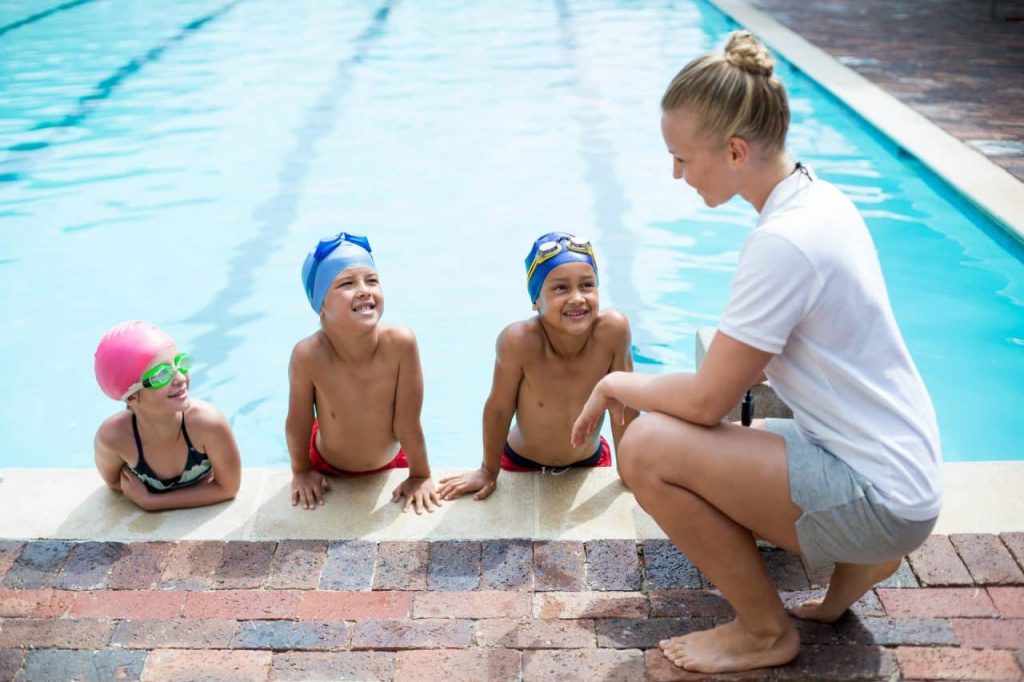
Swimming Lessons for All Ages!
What are the steps to learn how to swim?
Knowing how to swim is a great skill to have. Keep in mind that everyone learns at different levels, so these steps may not work for you. If you are fearful of water, scroll down to read how to get over your fear of swimming.
1) Become comfortable with the water
Begin practicing in the shallow end of a pool with your swimming instructor. You want to be sure you can stand up comfortably if you lose your balance or need to take a break.
2) Practice floating
Keep in mind, our body is naturally a pretty buoyant as we fill our lungs with air. All our bodies are different, though. You can practice floating, first, by holding onto the edge of a pool and lifting your legs off the ground. Practice both on your stomach and on your back while holding onto the edge of the pool. Once you feel comfortable floating while holding onto the edge, you can practice floating in the shallow end of a pool alone or with the assistance of your swimming instructor or another person.
If you ever panic while swimming in deep water, resort to floating on your back and try to relax. Give yourself time to calm down before beginning swimming again.
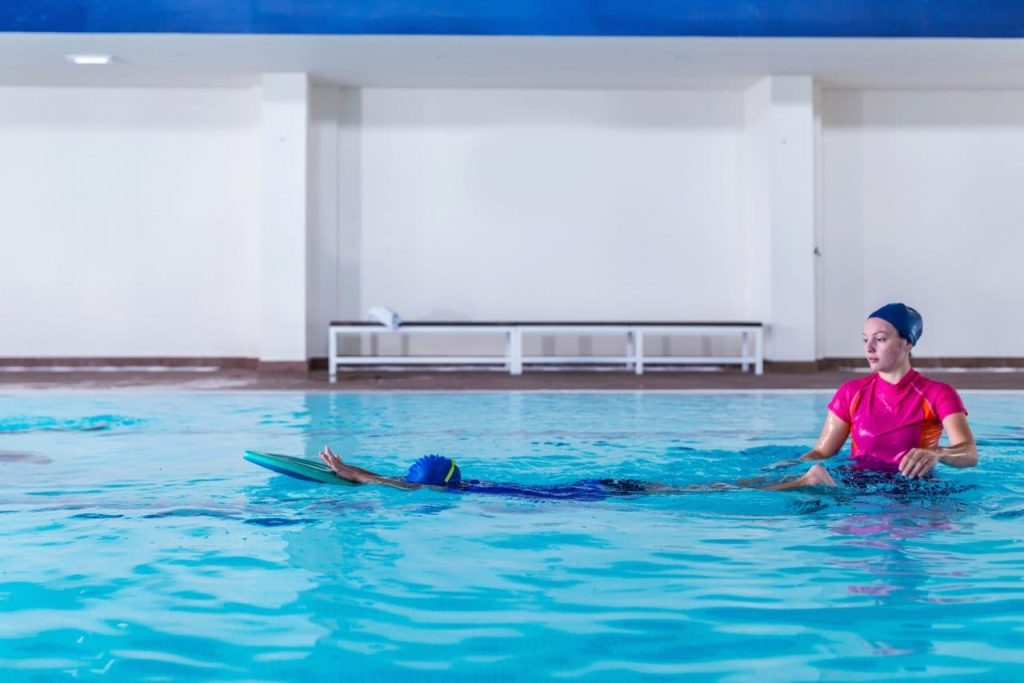
3) Practice blowing bubbles underwater
In the shallow end of the pool, take a deep breath before submerging your face underwater. Exhale fully with your nose. Small bubbles will form. You can also practice by exhaling through your mouth.
If you’re uncomfortable blowing bubbles through your nose, you can wear a nose plug or hold your nose closed with one hand and exhale through your mouth.
It also may be helpful to wear goggles while going underwater. Make sure the goggles fit properly or else water may enter them.
4) Practice kicking
The safest way to practice kicking is by holding onto the edge of a pool like in the picture below. The most typical kick to practice is a flutter kick. You will keep your legs fairly straight while alternating which leg is kicking. This is a great, and safe, way to practice kicking techniques while staying afloat.
Once you feel comfortable kicking while holding onto the edge of a pool, you can try practicing while floating on your back in shallow water.
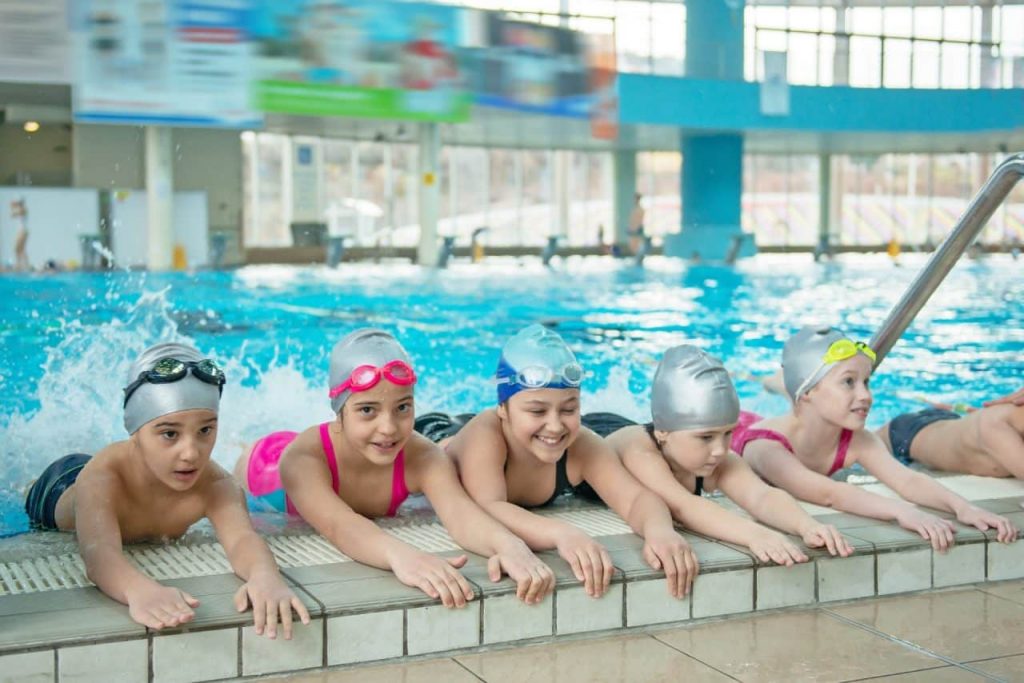
5) Practice arm strokes
Once you feel comfortable kicking your feet, you can begin practicing arm stroke techniques. To begin, start with backstroke. Not only is it one of the easier strokes to learn, but it will also keep your face above water. To perform a backstroke, start by floating on your back. You will then lift one arm straight out of the water, palm forward, fingers together. While keeping that arm straight, bring it back towards the side of your head, then underwater. Continue moving your arm in a circular motion along the side of your body and repeat. You will do this with both arms, alternating them.
You will also need to add in kicking with your legs. Flutter each of your legs with a slight bend in both knees. Keep your toes pointed.
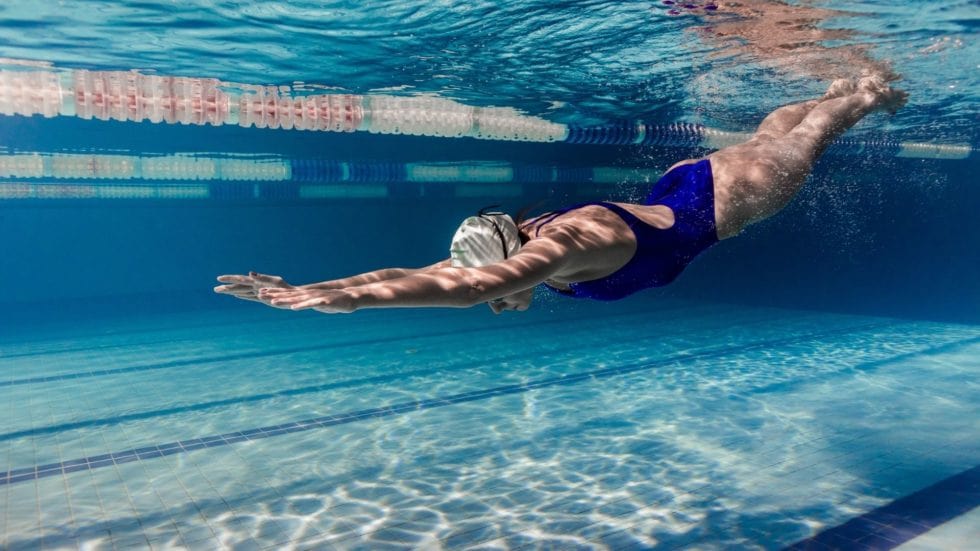
WARNING: While learning to swim alone, use a pool with a lifeguard. It is never recommended to swim alone unless you are a strong swimmer.
Practice Swimming Skills With a Certified Instructor
How do I get over my fear of swimming?
Many people are afraid of water and swimming simply because they were never taught how to swim. Others may be afraid because of a previous traumatic experience (e.g. almost drowning). How do you get over this fear and enjoy the water?
Take it slow and build confidence:
-
Mentally prepare yourself: Accept that you’ll be entering a pool and begin learning to swim. Fear is psychological and can be overcome. A swim instructor can be a great resource to help you face this fear.
Gradual acclimation to the water
-
Get comfortable around water: Start by simply sitting on the edge of the pool with your legs in the water. This will help you build water confidence at your own pace.
-
Gradually submerge your body: Slowly submerge more of your body into the water, eventually reaching chest-deep water.
Desensitize yourself to water on your face:
-
Splash your face: Once comfortable in chest-deep water, try splashing your face. You don’t need to go completely underwater unless you’re ready. This will help you get used to water touching your face.
Practice basic skills with support:
-
Go underwater (optional): When comfortable, take a deep breath and try going under the water for a few seconds each time. Wearing goggles and plugging your nose can help. Once underwater, blow bubbles out your mouth or nose.
-
Hold onto the pool edge and practice floating and kicking: This is a great way to get comfortable with these fundamental swimming techniques.
Invest in proper instruction:
-
Use flotation devices: If your child is nervous about the water, a pool noodle, swim board, or other flotation devices can offer a sense of security. These tools let your child get comfortable in the water while giving them extra support. They can be great for practicing kicking and basic arm strokes in a safe and enjoyable way, especially during those first swimming lessons.
-
Take swimming lessons: The best option is to learn how to swim with a trained instructor. Not only will they teach you proper swimming skills, like freestyle swimming and breathing exercises for swimming, but they will also help you face your fear and keep you safe during water safety training. Inquire about swimming classes to begin your journey towards enjoying the water! Remember, consistent practice swimming is key to improving your skills and building confidence.
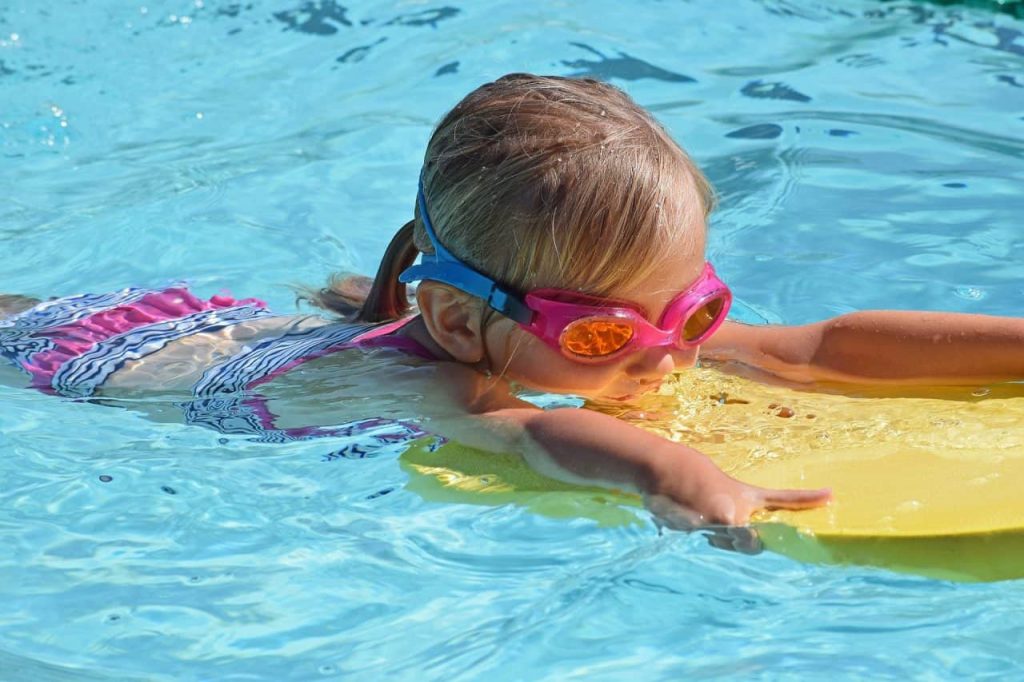
Important Safety Tips for Swimming with Children
Learning to swim is fun, but safety should always come first! Here are some important tips to keep in mind when children are in the water:
-
Adult Supervision: Never let children swim alone. Constant adult supervision is essential to ensure a safe enjoyable experience and make them feel confident.
-
Shallow End: Beginner swimmers should stay in the shallow end where they can stand up and never go near the deep end. This builds confidence and reduces risks. Being near the shallow end allows the children to regain their footing in water if ever they lose their balance.
-
Life Jackets: Experts suggest that life jackets and flotation devices should be worn by everyone, not just young children and inexperienced swimmers. These provide extra support and buoyancy for those still mastering their swimming skills.
-
Buddy Up: Encourage children to swim with a buddy for extra safety. This system enhances safety and makes swimming fun. Ensure that the companion is always within the reach of the child and both of them are aware of each other’s location at all times.
-
Breathing Techniques: Breathing techniques are as important as floating techniques. Start teaching children basic breathing techniques early on. Even simple practice like blowing bubbles helps familiarize them with breath control in the water. Constantly practicing these basic techniques could help them familiarize with the process and prepare them for more advanced skills later on.
Learning how to swim may seem like a daunting task to some, but it’s a great skill to have. You need to take time to practice your swimming skill in order to get better. Once you’re comfortable with your swimming abilities, you’ll be able to enjoy the pool, beach, lake and more with your friends and family safely. Enjoy the process, you’ll be swimming laps like a fish.
Invest In Yourself


Free First Aid Workshop for North York
It has been one year since the devastating North York van attack that left 10 people killed and 16 injured. On April 23, 2018, a man drove southbound on Yonge Street, plowing into pedestrians on the sidewalk between Finch and Sheppard. 9-1-1 was called and paramedics were dispatched to the site.
After this attack, Coast2Coast First Aid & Aquatics Inc organized and hosted a free First Aid training workshop for the Toronto community in hopes of breaking the bystander effect. “There’s too many people watching an incident happening and people don’t take action,” Ashkon Pour-Heidary, an owner of Coast2Coast First Aid & Aquatics, said. “You see a crowd and then you don’t know if you have to be the person to call 911 or not, or the other person has to call 911, and then at the end no one calls 911.”
The workshop was set up in stations under multiple tents where you could learn one part of First Aid and CPR skills at a time. There was a great turnout with many Toronto community members, including police officers and other trained professionals, with a desire to learn First Aid.
Coast2Coast First Aid & Aquatics plans to host another free First Aid and CPR training workshop near the anniversary date of the attack. We plan to set the workshop up the same as last year, making each tent a separate First Aid & CPR station which will be providing important life saving skills and techniques that will be critical in the moment of emergency. We will supply proper First Aid training equipment including CPR dummies and will be taught by Canadian Red Cross trained instructors.
We are planning to do this event even bigger and better by inviting non-profit organizations to come out and join our cause to raise awareness for safety preparedness as well as help us raise money.
Celebrate Life-Saving Heroes!
heck out our “Train the Next Hero” photo gallery for 2024! Discover inspiring moments from our training sessions and see how everyday individuals are becoming heroes in their communities.
2024 Update! Join us for our next Train the Next Hero in August.
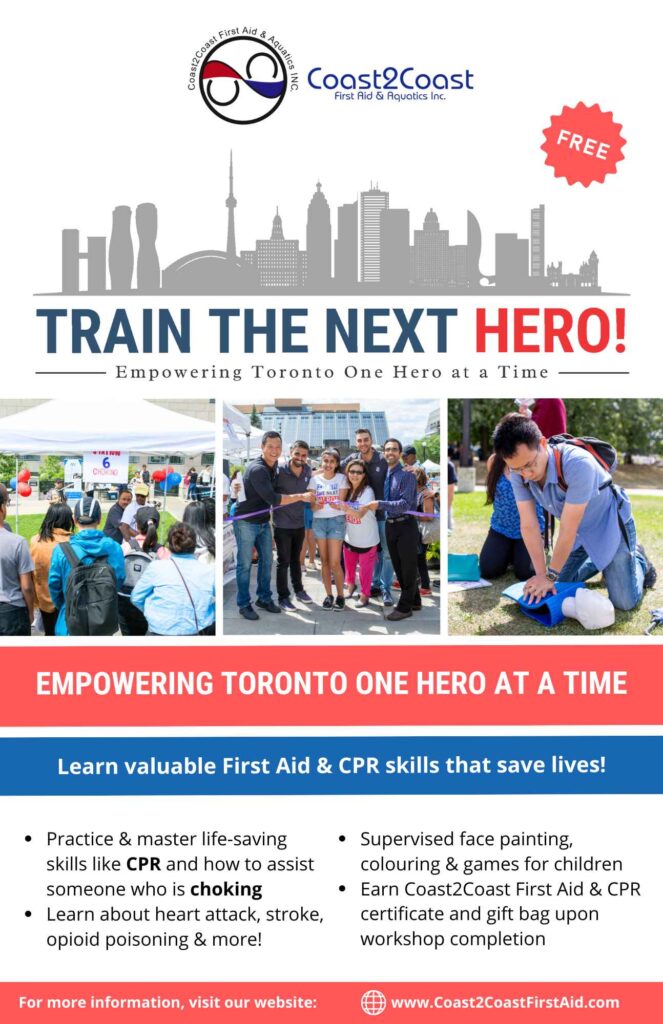
Get ready for the upcoming event in North York, “Train the Next Hero 2024,” where Toronto citizens can participate in a free first aid and CPR workshop. This highly anticipated event has garnered immense interest in previous years, with over 800 enthusiastic attendees. It’s a unique opportunity for individuals to learn life-saving skills that could make a significant difference in emergency situations. Whether you’re a newcomer eager to learn or a seasoned citizen looking to refresh your knowledge, this workshop promises to empower and equip attendees with essential first aid techniques. Don’t miss out on this chance to be prepared and potentially save lives!
Register for First Aid Training
Register today for a First Aid training course and learn how to deal with emergencies and keep your loved ones safe! Check out our facilities and book your spot now.
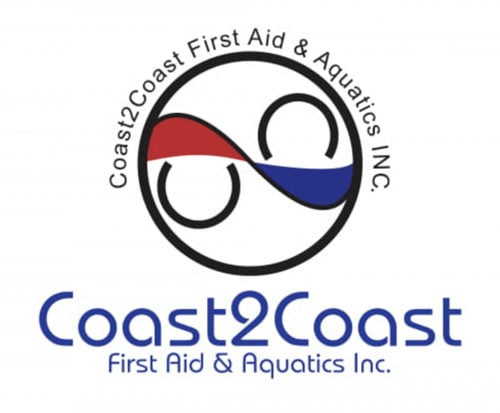

Essential Steps to Stop Bleeding with First Aid
Some of us think only accidents happen to those who take part in risky behavior or are on the more adventurous side, but the truth is an accident can occur anywhere at any time. Besides choking, internal and external severe bleeding are some of the most common emergencies we experience and are unaccustomed to handling unless we have proper First Aid training and a first aid kit at hand.
Continue readingShould Children Learn CPR?
The story of two boys saving their grandma from death using CPR skills their mother taught them is an amazing feature, and further proves that even with just a little training, all can save lives no matter what age or size.
Continue readingWhat is an AED and where can you find it?
You are in a scenario where you see someone grab their chest, lose all colour in their face, and suddenly drop to the ground, unconscious while displaying no movement or breathing. The signs resemble of someone suffering from a Sudden Cardiac Arrest (SCA). You know CPR (cardiopulmonary resuscitation), but where is the closest defibrillator?
Decreasing the time it takes to locate an Automated External Defibrillator (AED) is essential to the little time you have to save one’s life. If an AED is used on a sudden cardiac arrest victim within the first minute of collapse, their probability of survival is 90%. For every minute that passes, their likelihood of survival drops 10%, leaving a 10 minute ‘window of opportunity.’
Where is your nearest DEFIB (AED)?
Not every defibrillator has their location registered. The location varies in every town, but defib’s are universally located in large public places, such as:
- Hospitals – Hospital wings, or at the closest nursing station
- Community Centres – Foyer (front entrance)
- Schools – Front office or staff room
- Business Centres – Ground level, next to the evacuation/escape plan
- Golf, Football, Soccer, Swimming, Hockey and Cricket Clubs – Function rooms
- Gymnasiums – Hinged and signed on the walls near gym equipment. Try the wall closest to the treadmills or cardio equipment
- Shopping Malls/Centres – Guest services and public washrooms
- Public Libraries – Foyer (front entrance)
- Zoo’s – Front office and staff room.
What you MUST know before using an AED (Automated External Defibrillator)?
Before using an AED, understanding its proper usage is crucial. The following YouTube short guides you through essential tips every potential responder should have to help someone with an AED. These seven tips will help you remember the right ways to operate a defirillator in a cardiac arrest emergency. Whether you’re at home, work, or in public spaces, being prepared can make all the difference. Watch now to learn how to confidently and effectively use an AED in critical moments.
Be Prepared for Emergencies!
How does a Defib work?
Defibrillation operates by delivering an electrical current through the heart muscle, via the defibrillation pads. All electrical activity in the heart becomes pulseless, in the belief that when the pulse returns, it will be in a rhythm that is coordinated with an effective pumping motion.
Survival rates are the highest when defibrillation is given within the first few minutes of the time of the collapse. Greater defibrillator availability and recognition of device locations will increase the survival rates of sudden cardiac arrests victims. Coast2Coast offers CPR/AED courses that properly educate how to administer a defibrillator, and how to recognize and respond to those in a cardiovascular emergency.
How to perform a primary survey and what is DRSABCD?
Primary survey is the first thing that should be done when observing and helping a victim in need. The abbreviation DRSABCD is the acronym check-list we ask bystanders to use to in the process of saving lives.
D = Danger. Check for danger before approaching the victim. Whereabouts to check for may include live wires, exposed needles, or flammable liquids. Your safety ALWAYS comes first.
R = Response. Attempt to get a response from the victim by asking them to say their name or squeeze your hand.
S = Send for Help. If there is no response, now is the time to call 911. If there are other people present at the scene, send someone to locate the nearest defibrillator.
A = Airway. Is the airway clear? Check to make sure the victim has nothing in their mouth, such as broken teeth, food or vomit.
B = Breathing. Once a clear airway is established, check to see if the victim is breathing.
C = Compressions. Commence chest compressions at a rate of 30 compressions to 2 breaths. You should be pushing at the depth of 1/3 of the victim’s chest, and at a rate of 100 chest compressions per minute (this will be interrupted by administering their breathing). Coast2Coast teaches you the proper method of compressions and how not to over-exert yourself of energy.
D = Defibrillator. Apply the defibrillator following the voice prompts. If emergency medical staff are there applying the AED, follow their instructions.
It is never too late to learn CPR and how to accurately use a defibrillator; contact Coast2Coast to find out more about our CPR/AED courses and becoming a lifesaver today!
